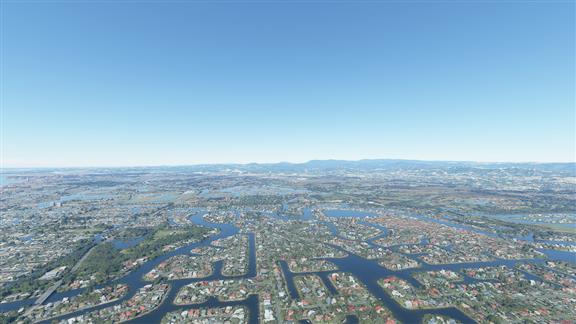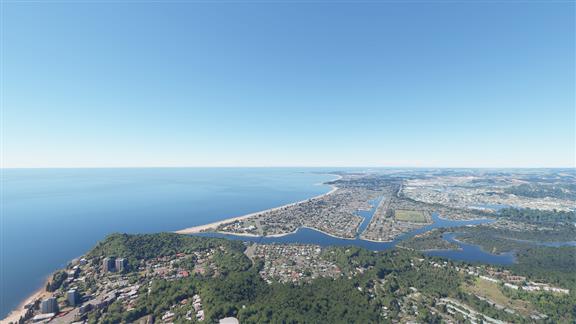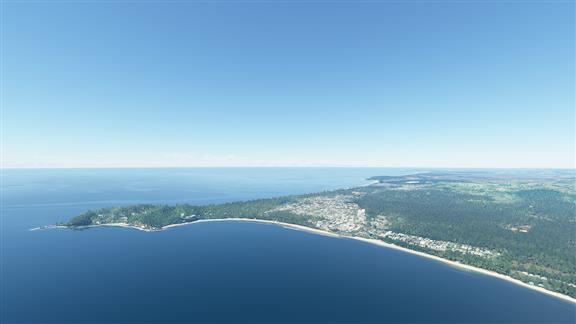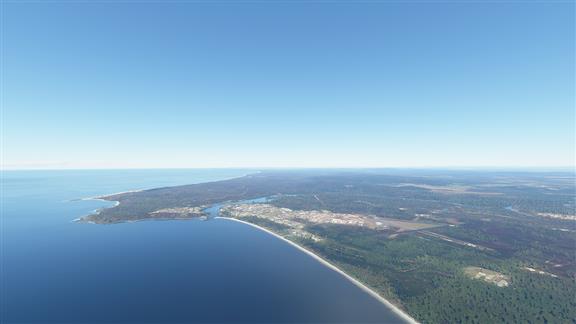Evans Head
Evans Head

The Aboriginal peoples of Australia are thought to have originally emigrated from Africa over 70,000 years ago, eventually spreading to south east Asia. Be that as it may, genetic testing has concluded that all Australian Aboriginals share a common ancestor who lived on the mainland around 50,000 years ago. That makes these peoples the oldest population of humans outside of Africa. It is presumed they made it to Australia in primitive boats as there is evidence of habitation in Australia that is 50,000 years old. Later arrivals could have simply walked here during the last glaciation.
At present there are two distinct groups of Aboriginal Australians: the Aboriginal peoples, who already lived here when the British arrived, and the Torres Strait Islanders, more recent arrivals. Within the Aboriginal peoples, there are over 250 distinct groups, or mobs, based on language. 71 of these are indigenous to the present boundaries of New South Wales. To the far north east of New South Wales, in the Northern Rivers region near Evans Head, is the ancestral home of the Bundjalung.
The Bundjalung people are a federation of 15 smaller groups and clans. The Bundjalung nation is bordered to the north by the Yuggera and Barrunggam nations; to the south by the Gumbaynggirr nation; to the west by the Ngarabal nation and to the east by the Tasman sea. The Tasman Sea is, of course, a clearly defined border. But the others are less physically defined and more a matter of etiquette.
Historically, different Aboriginal nations were constantly at war with each other. But you have to understand what that means. They had no concept of war and peace such as Europeans have. The nations had a spiritual tie to a specific place, and conquering another's place would have no particular benefit. Rigorously defending your land, on the other hand, was of paramount importance. So whenever a formal battle between groups arose, the invaders would go home happy when a couple of the opposing warriors had been killed or wounded, whereas for those defending their land, everyone was involved; warriors (men), soon-to-be-warriors (boys), and even the women. Unfortunately for the women, their role in the war was quite often as spoils. Raiding another territory for women was commonplace. Women were considered valuable property, and their theft could not go unanswered. So a raid would bring about a revenge raid, which would then require its revenge, and so on. But it would never enter one nation's thoughts to wipe out another nation, or take their land. Because the dreams are one with the land and the people.
The Dreamtime was a long time ago; it was the very beginning. But it is still the beginning, and the Dreamtime has never ended. During the Dreamtime, when the earth was flat and grey, great spirits arose from their ancient slumber. As they wandered to and fro, performing ceremonies, searching for food and digging for water, because of their great size they formed the rivers, mountains and ravines. The greatest of these spirits was the Rainbow Snake, who, along with another spirit, Dirawong, created the land of the Bundjalung. Dirawong was a benevolent spirit, and gave the Bundjalung laws and ceremonies to cover every eventuality. Except Europeans.
In 1842, English settlers were taking over land given to the Bundjalung by the Dreamtime Spirits at Pelican Creek, north of Evans Head. The land was rich in red cedar. The settlers set up a storehouse where sailing vessels could pick up the cedar and drop off supplies for the sawyers. Five men and one boy were left to guard the stores. When the teamsters arrived one morning to drop off wood and pick up the supplies for distribution, they found all five men brutally mutilated and all of the supplies missing or destroyed, but the boy was unharmed and hiding in the woods. Word quickly spread to the neighbouring Europeans, who formed a mounted posse to take revenge. There followed the Evans Head massacre, followed by the East Ballina massacre, followed by the South Ballina Poisoning. Hundreds upon hundreds of Bundjalung were killed, some by simply herding them off cliffs.
This style of war was beyond the grasp of the Bundjalung. No revenge was taken. But the stories of escape; of being shot and buried in the forest north of Ballina; of being dumped off the cliff at Black Head, or simply being left to rot at Angels Beach, are now a part of the dreams. And the dreams are one with the land and the people.
In 1983 the New South Wales Land Rights Act passed into law. Its preamble states:
1. Land in the State of New South Wales was traditionally owned and occupied by Aborigines.
2. Land is of spiritual, social, cultural and economic importance to Aborigines.
3. It is fitting to acknowledge the importance which land has for Aborigines and the need for Aborigines of land.
4. It is accepted that as a result of past government decisions the amount of land set aside for Aborigines has been progressively reduced without compensation.
In 1985 a 16 hectare section of Goanna Headland at Evans head became the first aboriginal land grant in New South Wales. Goanna Headland is in the dreams of the Bundjalung as the spot where the original three brothers arrived by sea and populated the area.
So that's the back story to Evans Head.
 You wouldn't believe the noise this thing makes climbing out.
You wouldn't believe the noise this thing makes climbing out.
|
 I see no way around it; I have to break the fourth wall. In reality, this whole area is a scene from Noah's ark. We have a somewhat rosier view of reality here. So deal with it.
I see no way around it; I have to break the fourth wall. In reality, this whole area is a scene from Noah's ark. We have a somewhat rosier view of reality here. So deal with it.
|
 Russell Island is a mangrove-and-mud kind of a place. Land is cheap here and while many come here for its rustic charms, many more come here because they can't afford a trailer on the mailand. But apparently the cane toads have wiped out most of the death adders, so that's nice.
Russell Island is a mangrove-and-mud kind of a place. Land is cheap here and while many come here for its rustic charms, many more come here because they can't afford a trailer on the mailand. But apparently the cane toads have wiped out most of the death adders, so that's nice.
|
You can see how these guys were just asking for a flood.
 |
 |
 This is the Gold Coast. Originally called the South Coast (in relation to Brisbane), it was referred to as the Gold Coast in a somewhat derogatory manner back in the 50's due to escalating prices, real estate in particular. And then, however those things happen, the name was changed officially. The place is known for its beaches, surfing, nightlife, theme parks, basically anything a tourist would want to spend money on. Even parking.
This is the Gold Coast. Originally called the South Coast (in relation to Brisbane), it was referred to as the Gold Coast in a somewhat derogatory manner back in the 50's due to escalating prices, real estate in particular. And then, however those things happen, the name was changed officially. The place is known for its beaches, surfing, nightlife, theme parks, basically anything a tourist would want to spend money on. Even parking.In 1965 city council decided to put parking meters in the city so as to cash in on that source of revenue. Bernie Elsie, of the Surfer's Paradise Progress Association, felt that move was bad for business, at least in Surfer's Paradise, which is a suburb of the Gold Coast. So he hired a bunch of beautiful women, dressed them gold lamé bikinis and tiaras, and set them lose as meter maids. Their job was to feed any expired meters they found where someone was parked and about to get a ticket. Now feeding a meter that is not your own is, in fact, illegal. But city council turned a collective blind eye on the maids' activities because they were becoming iconic. So much so, that in 1967, when a devastating cyclone kept the tourists away, the mayor, one Bruce Small, toured Australia with a group of maids to promote tourism. The maids have had a few problems over the years, the largest of which is funding. It is frightfully expensive to hire people to give away money. Then there were the inevitable scandals - some maids went on to Penthouse; some naughty videos surfaced, stuff like that. So in the early 2000s there were efforts to 'dress up', so to speak, the meter maid image, with khaki shirts, shorts and sensible shoes. There was even talk of meter boys. These efforts have, of course, led to outrage from those who consider the original gold bikini clad maid to be historically accurate. Sadly, the necessity for meter maids has gone away. The City of Gold Coast, along with the rest of the world, has been phasing out old time parking meters in favour of something a little more high-tech. In-ground sensors are embedded in all parking spaces to alert the authorities to the general distribution of parked cars and especially those exceeding the two-hour parking limit. A phone app makes the payment process much more streamlined, but you can also go to a pay-by-plate kiosk where you park. Since everything is driven by plate number there is no indication to someone, say, in a bikini, as to which cars are about to expire. So the person parking will have to take care of it themselves. Rates vary depending upon the popularity of where you choose to park. You can pay as little as $1.40 an hour in Burleigh Heads, but if you want to be closer to the action you'll generally pay $2.80 per hour. Of course the best surfing, and therefore the highest parking rates at $4.10 per hour, are to be found in Surfer's Paradise. The ancestral home of the meter maids. |
 Runaway Bay. Called "Ground Zero" for the Gold Coast floods by Channel 9 News, but they sometimes wax dramatic.This region got 200 mm (7.9 inches) of rain in a couple of hours on the night of 22 March 2021. Just upstream from here, there was major flooding of the Logan and Albert rivers, which caused Gold Coast City Council to announce an evacuation of all residents on the two roads leading up to that area. I can't find anything about how Runaway Bay fared in particular, but just looking at it, I would say not well.
Runaway Bay. Called "Ground Zero" for the Gold Coast floods by Channel 9 News, but they sometimes wax dramatic.This region got 200 mm (7.9 inches) of rain in a couple of hours on the night of 22 March 2021. Just upstream from here, there was major flooding of the Logan and Albert rivers, which caused Gold Coast City Council to announce an evacuation of all residents on the two roads leading up to that area. I can't find anything about how Runaway Bay fared in particular, but just looking at it, I would say not well.
|
 Burleigh Heads. Cheap parking here.
Burleigh Heads. Cheap parking here.
|
 Coolangatta, which means we're at the end of both the Greater Gold Coast and Queensland.
Coolangatta, which means we're at the end of both the Greater Gold Coast and Queensland.The Coolangatta was a schooner that was wrecked here in 1846 whilst loading red cedar. The crew had to walk back to Brisbane, 110 km away. Enroute they were welcomed and fed by different Aboriginal nations. Once they got out of Bundjalung territory, that is. |
 Point Danger, with Snapper Rocks this side of the point and Froggy Beach the other. We are now entering New South Wales.
Point Danger, with Snapper Rocks this side of the point and Froggy Beach the other. We are now entering New South Wales.
|
 That's more like it. It's too built up around the Gold Coast. This is the area around Wooyung. There used to be a Bora Ring in the wetlands here - two circles built generally of stones, and connected by a pathway. One circle was larger than the other - perhaps thirty meters in diameter. This was the public circle, and everyone was welcome in it. No women or children of course, but everyone else. Boys who were reaching puberty, and therefore becoming men, would walk from the public space in the larger circle, along the pathway, to the much smaller sacred circle. The only ones allowed in this circle were those to be initiated into manhood and the elders, who would teach the initiands the sacred songs, the tribe's religious visions, dances and lore. Bora Rings were easily destroyed by people needing a good big rock for something, so you don't find many of them these days.
That's more like it. It's too built up around the Gold Coast. This is the area around Wooyung. There used to be a Bora Ring in the wetlands here - two circles built generally of stones, and connected by a pathway. One circle was larger than the other - perhaps thirty meters in diameter. This was the public circle, and everyone was welcome in it. No women or children of course, but everyone else. Boys who were reaching puberty, and therefore becoming men, would walk from the public space in the larger circle, along the pathway, to the much smaller sacred circle. The only ones allowed in this circle were those to be initiated into manhood and the elders, who would teach the initiands the sacred songs, the tribe's religious visions, dances and lore. Bora Rings were easily destroyed by people needing a good big rock for something, so you don't find many of them these days.
|
 Cape Byron, the easternmost point on mainland Australia, and the town of Byron Bay. They've had to cancel the Bluesfest due to Covid Concerns. Also apparently Chris Hemsworth, Olivia Newton-John and Matt Damon all live here. Lotta stuff on that internet.
Cape Byron, the easternmost point on mainland Australia, and the town of Byron Bay. They've had to cancel the Bluesfest due to Covid Concerns. Also apparently Chris Hemsworth, Olivia Newton-John and Matt Damon all live here. Lotta stuff on that internet.
|
 Ballina. Deep in Bundjalung territory now. Also just plain deep. On March 23rd, 2021 there were 58 road closures and 67 cautions, according to the Ballina Shire Advocate. Place doesn't look that big.
Ballina. Deep in Bundjalung territory now. Also just plain deep. On March 23rd, 2021 there were 58 road closures and 67 cautions, according to the Ballina Shire Advocate. Place doesn't look that big.
|
 A shire is sort of like a county and sort of not, especially in Australia. Might talk about that later. For now, it suffices that we're in Ballina Shire, and it produces (as of 2015/16) almost 75 million dollars worth of agricultural products such as nuts and cut flowers every year.
A shire is sort of like a county and sort of not, especially in Australia. Might talk about that later. For now, it suffices that we're in Ballina Shire, and it produces (as of 2015/16) almost 75 million dollars worth of agricultural products such as nuts and cut flowers every year.
|
 And here we are in Evans Head. While we're here we've got to visit the F111 museum. The F111, lovingly nicknamed the pig, was the mainstay of the RAAF from 1973 until their retirement in 2010.
And here we are in Evans Head. While we're here we've got to visit the F111 museum. The F111, lovingly nicknamed the pig, was the mainstay of the RAAF from 1973 until their retirement in 2010.
|
 Well, it isn't much but it's home for the night. Tomorrow we're off to the Big Banana.
Well, it isn't much but it's home for the night. Tomorrow we're off to the Big Banana.
|